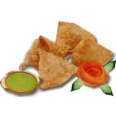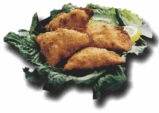The SAMOSA probably travelled to India along ancient trade routes from Central Asia. Small, crisp mince-filled triangles that were easy to make around the campfire during night halts, then conveniently packed into saddlebags as snacks for the next day's journey. According to the “The Oxford Companion to Food” the Indian samosa is merely the best known of an entire family of stuffed pastries or dumplings popular from Egypt and Zanzibar to Central Asia and West China. Arab cookery books of the 10th and 13th Centuries refer to the pastries as sanbusak (the pronunciation still current in Egypt, Syria, & Lebanon), sanbusaq or sanbusaj, all reflecting the early medieval form of the Persian word: sanbosag. Claudia Roden (1968) quotes a poem by Ishaq ibn Ibrahim-al-Mausili (9th Century) praising the sanbusaj.


By the early 14th Century, it was not only a part of Indian cuisine but also food fit for a king. Amir Khusrao, prolific poet of Delhi royalty, observed in 1300 that the royal set seemed partial to the "samosa prepared from meat, ghee, onion and so on". In 1334, the renowned traveller Ibn Battuta wrote about the sambusak: "minced meat cooked with almonds, pistachios, onions and spices placed inside a thin envelop of wheat and deep-fried in ghee". And the samosa obtained a royal stamp with its inclusion in the Ain-i-Akbari which declared that among dishes cooked with wheat there is the qutab, "which the people of Hind called the sanbusa".
The current day samosas are small, crispy, flaky pastries that are usually deep-fried. They are stuffed with an assortment of fillings ranging from minced meat with herbs and spices to vegetables such as cauliflower and potatoes. In Bengal one finds samosas filled with sweetened reduced milk that go straight from the frying pan to a syrup wash. But whatever the filling, samosas are a treasured snack---the perfect companion to a cup of chai.